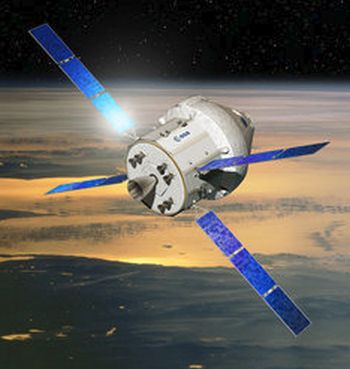Orion Spacecraft On Target For 2014 Test Flight
By Space Coast Daily // February 28, 2013
Testing Continues On New NASA Vehicle
BREVARD COUNTY • KENNEDY SPACE CENTER, FLORIDA – As the first test flight of the new Orion spacecraft draws closer, NASA is throttling up efforts to have the multi-purpose vehicle ready by 2014.

NASA continues to develop Orion for deep-space voyages while testing and assembly of the vehicle are made at the Operations and Checkout Building at the Kennedy Space Center.
The spacecraft has been scheduled for a September 2014 test flight aboard a United Launch Alliance Delta 4 heavy booster rocket and has been fully funded even if sequestration reductions are imposed upon NASA.
That flight, called Exploration Flight Test-1, is expected to examine the Orion’s avionic capabilities, its heat shield and a host of other electronic systems as it reaches an altitude of about 3,600 miles above the earth.
The test is expected to wrap up with a splashdown and recovery in the Pacific Ocean.
But getting to that point has not been without problems for NASA engineers.
During a test at Kennedy Space Center of the capsule’s pressure integrity in November, three small cracks were found in the bulkhead of Orion’s pressurized shell.
The cracks were as much as a half-inch, but NASA engineers believe they have found a solution to remedy the situation.

A new fan-shaped double-structural shell will help Orion handle pressure caused by launch and re-entry by distributing weight loads across a wide area of the spacecraft.
The fix will be tested in February before NASA engineers add a variety of systems to the test vehicle.
NASA expects to install Orion’s heat shield by this summer, along with powering up the vehicle’s advanced avionics systems by the end of June.
The test vehicle is expected to be turned over to launch operations by the end of the year.
According to a NASA press release, the Orion multi-purpose crew vehicle features dozens of technology advancements and innovations that have been incorporated into the spacecraft’s subsystem and component design.
To support long-duration deep space missions of up to six months, NASA engineers have worked since 2004 to develop the state-of-the-art spacecraft. Its unique life support, propulsion, thermal protection and avionics systems will enable integration of new technical innovations in the future.
Building upon the best of human spaceflight design and experience, the spacecraft includes both crew and service modules, a spacecraft adaptor, and a revolutionary launch abort system that will significantly increase crew safety.
Orion’s crew module is much larger than than that of the Apollo spacecraft and can support more crew members for short or long-duration spaceflight missions.
The service module is the powerhouse that fuels and propels the spacecraft as well as the storehouse for the life-sustaining air and water astronauts need during their space travels. The service module’s structure will also provide places to mount scientific experiments and cargo.
And Orion is capable of transporting astronauts on a variety of expeditions beyond low Earth orbit – ushering in a new era of space exploration, NASA says.












